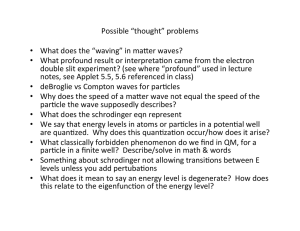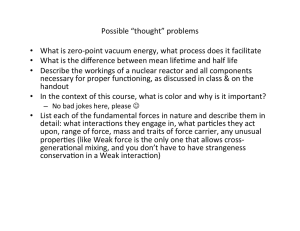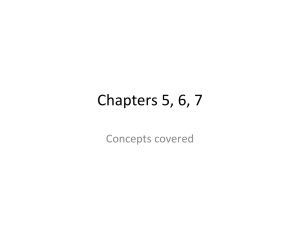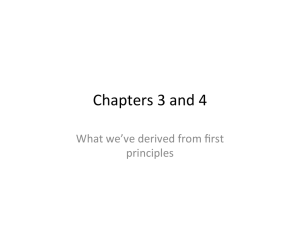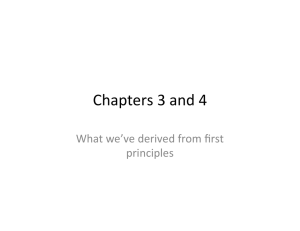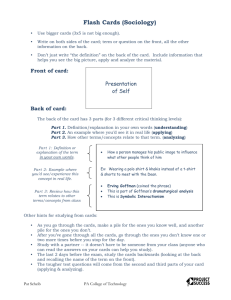Efficient Par,cle Filters for high‐dimensional systems Peter Jan van Leeuwen and Mel Ades Data‐Assimila,on Research Centre DARC
advertisement
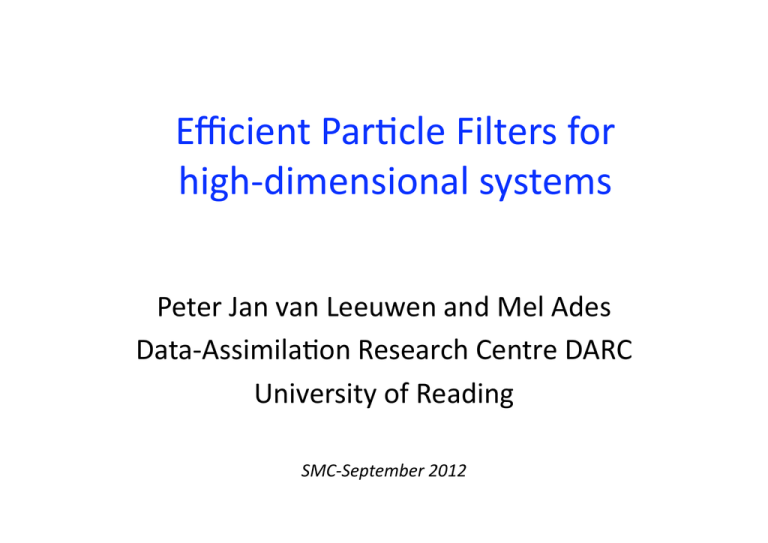
Efficient Par,cle Filters for high‐dimensional systems Peter Jan van Leeuwen and Mel Ades Data‐Assimila,on Research Centre DARC University of Reading SMC‐September 2012 How is DA used today in geosciences? Present‐day data‐assimila,on systems are based on lineariza,ons and state covariances are essen,al. 4DVar, Representer method (PSAS): ‐ Gaussian pdf’s for the state, solves only for posterior mode, needs error covariance of ini,al state (B matrix) (Ensemble) Kalman filter: ‐ assumes Gaussian pdf’s for the state, approximates posterior mean and covariance, doesn’t minimize anything in nonlinear systems, needs infla,on and localisa,on Combina,ons of these: hybrid methods (!!!) Nota,on • Prior knowledge, the Stochas,c PDE: • Observa,ons: • Rela,on between the two: Nonlinear filtering: Par,cle filter Use ensemble with the weights. Why are par,cle filters degenerate I Probability space in large‐dimensional systems is ‘empty’: the curse of dimensionality u(x1) u(x2) T(x3) Why are Par,cle Filters degenerate II • The volume of a hypersphere of radius r in an M dimensional space is • Taking for the radius we find, using S,rling: • So very small indeed. Why are Par,cle Filters degenerate III For the optimal proposal density we find, for Gaussian process model and Gaussian observation errors: Ignoring covariances we find: Why are Par,cle Filters degenerate? • ‘Number of par,cles needed grows exponen,ally with dimension of the state vector (Bickel et al, 2007).’ • A slightly different view: degeneracy due to number of independent observa,ons. • This is related to the extremely narrow likelihood, a ,ny move of a par,cle gives a completely different weight. The sta,s,cs • The Stochas,c PDE: • Observa,ons: • Rela,on between the two: Assume: H is linear The Equivalent‐Weights Par,cle Filter • Use simple proposal at each ,me step, e.g. ‘nudging’. • Use different proposal at final ,me step to ensure that weights are very similar. t=0 y y t=50 t=100 Proposal density between observa,ons We can explore the fact that the model needs several O(100) time steps between observations, e.g. by using a relaxation term in the proposal: Corresponding to an evolution equation for each particle Proposal density between observa,ons • One could also use the ‘optimal proposal density’ between observations. • This can be implemented as a minimization method for each particle, and is also known as the Implicit Particle Filter. • This is related to a method called 4DVar in meteorology and oceanography, which explores only the mode of the joint-in-time pdf. Proposal density at observa,on ,me: the essence of the Equivalent‐Weights Par,cle Filter The proposal density depends on the maximum weight from a deterministic particle can achieve during the last time step: The target weight is set by the user, as e.g. the weight that 80% of the particles can achieve. The maximum weights 1. We know: 2. Write down expression for each weight ignoring proposal: 3. When H is linear this is a quadratic function in xin for each particle. Otherwise linearize. The target weight 1 4 3 Target weight 2 5 xin The Equivalent‐Weights Par,cle Filter The proposal density is chosen as: The target weight is set by the user, as e.g. the weight that 80% of the particles can achieve. The two proposal densi,es For particles that can reach the target weight we use: For particles that cannot reach the target weight we use: The determinis,c move X yn ximax f(xin-1) target weight X weight contour Determine with at crossing of line with target weight contour in: Equivalent‐Weights Par,cle Filter • Use relaxa,on‐term proposal up to last ,me step • Calculate wimax and target weight (e.g. 80%) • Calculate determinis,c moves for high‐weight par,cles: • Determine stochas,c move • Calculate new weights and resample ‘lost’ par,cles How essen,al are Gaussian assump,ons? • Allows for analy,cal expressions. • But no real need. • wimax calcula,ons do not have to be very accurate. • Same for wtarget. • Determinis,c move has to be very accurate, good itera,ve schemes should be used. Applica,on: the barotropic vor,city equa,on • Stochas,c barotropic vor,city equa,on: • • • • • • 256 by 256 grid ‐ 65,536 variables Doubly periodic boundary condi,ons Semi‐Langrangian ,me stepping scheme Twin experiments Observa,ons every 50 ,me steps – decorrela,on ,me of 42 32 par,cles Fully observed system Individual particles are not smooth. The update of the unobserved part Particle 23 before update Particle 23 after update Difference Time evolu,on for different relaxa,on strengths ¼ observa,ons over half of state Marginal posterior probability densi,es Convergence of the pdf’s 32 particles 128 particles 512 particles Rank histograms Full state observed ¼ of half state observed Miss‐specifica,on of process noise Truth: LQ=5 gridpoints EW-PF: LQ=9 gridpoints Miss‐specifica,on of process noise Truth: Q=0.025 EW-PF: Q=0.1 Conclusions • Particle filters do not need state covariances. • Degeneracy is related to number of observations, not to size of the state space. • Proposal density allows enormous freedom • Equivalent-weights scheme solves dimensionality problem? • Other efficient schemes are being derived. • Future plans: numerical weather prediction, climate forecasting References All references can be found on my website http://www.met.reading.ac.uk/~xv901096/research/publications.html • • • • • Nonlinear Data Assimilation in geosciences: an extremely efficient particle filter Van Leeuwen, P.J., Q.J.R.Meteorol.Soc., 136, 1991-1996, doi:10,1002/ qj699, 2010. Efficient non-linear Data Assimilation in Geophysical Fluid Dynamics Van Leeuwen, P.J., Computers and Fluids, doi:10,1016/j.compfluid.2010.11.011, 2011. Efficient non-linear Data Assimilation for ocean models of intermediate complexity Van Leeuwen, P.J., IEEE Statistical Signal Processing workshop, Nice, 28-30 June, doi: 10.1109/SSP.2011.5967700, 2011. Efficient fully nonlinear data assimilation for geophysical fluid dynamics Van Leeuwen, P.J. and M. Ades, In Press, Computers and Geosciences, http:// dx.doi.org/10.1016/j.cageo.2012.04.015, 2012. An exploration of the Equivalent-Weights Particle Filter Ades, M., and P.J. Van Leeuwen, In Press, Q. J. Royal Meteorol. Soc., 2012.
